Samsung Galaxy Note9 Performance & Battery Showdown: Snapdragon vs Exynos
by Andrei Frumusanu on November 26, 2018 8:00 AM ESTSystem Performance - Still a large(r) contrast
The performance difference between the Snapdragon and Exynos S9’s was among by biggest complaints about the latter variant. Here there’s a stark difference in software quality between what Qualcomm and S.LSI were able to deliver. Let’s see if the Note9 improves this in any way:
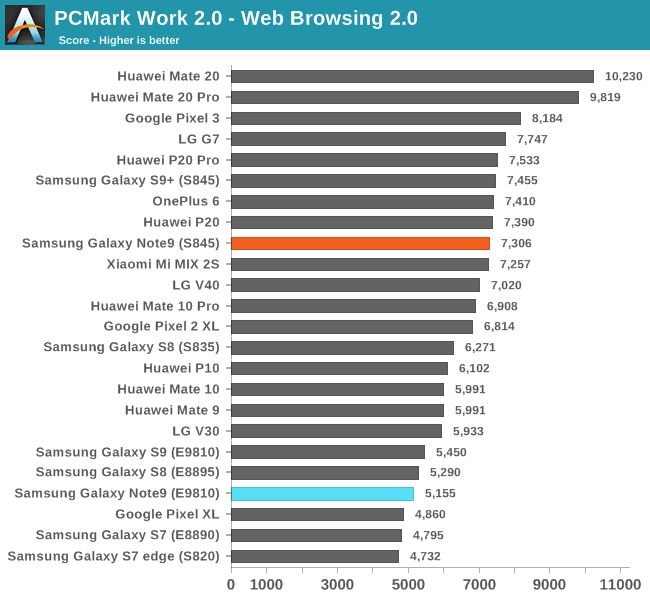
The Exynos Note9 here unfortunately doesn’t really improve on the S9, and even shows a slight regression.
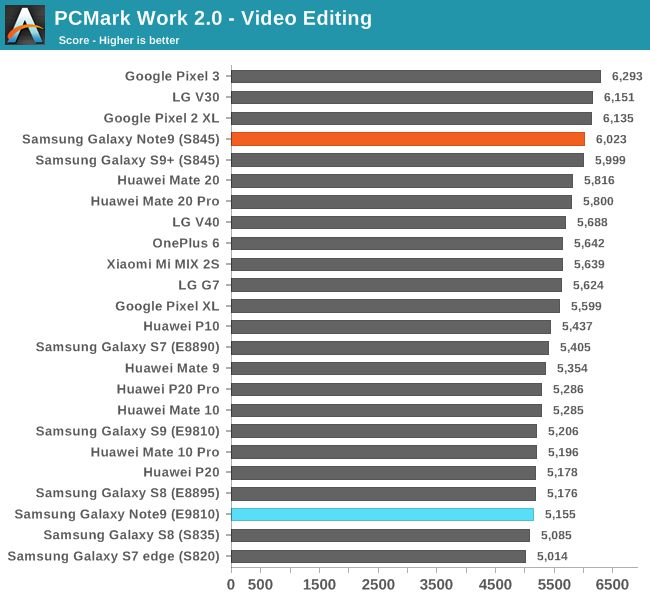
The video editing test further showcases the same behaviour, with the Snapdragon Note9 being in line with the S9+ result, while the Exynos Note9 is in line with the S9 result.
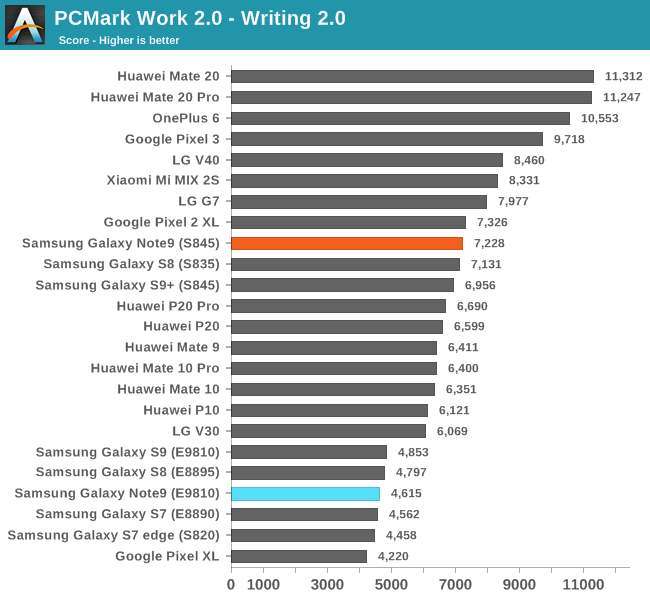
The writing test of PCMark is in my opinion one of the most important tests in our suite, as its results pretty much directly correspond to the actual perceived speed of a device in a lot of every-day scenarios. The test makes heavy usage of common Android APIs to achieve representative usage of common tasks such as text editing and PDF rendering.
The Exynos Note9 here seems again to showcase a slight performance degradation over the S9, but it’s all within margins of error.
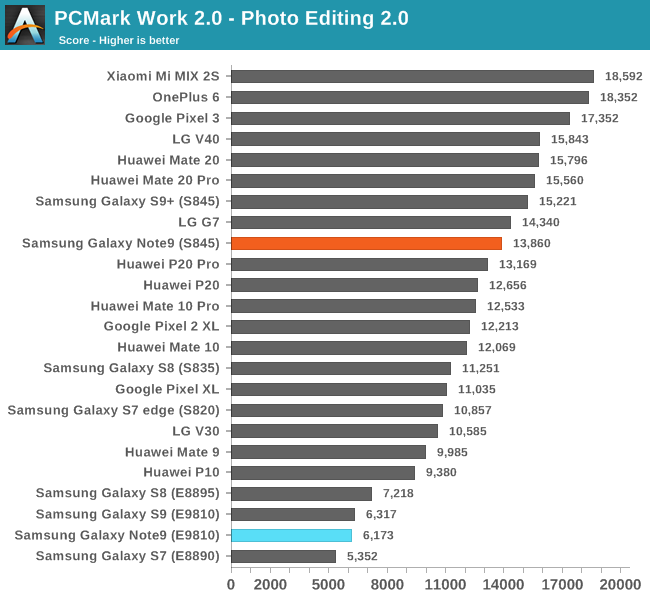
The photo editing test consists of small bursts of workloads making use of Android’s image processing APIs. This test’s key feature is that it is very sensitive to the responsiveness of the system, in other words, how fast the SoC can ramp up its performance.
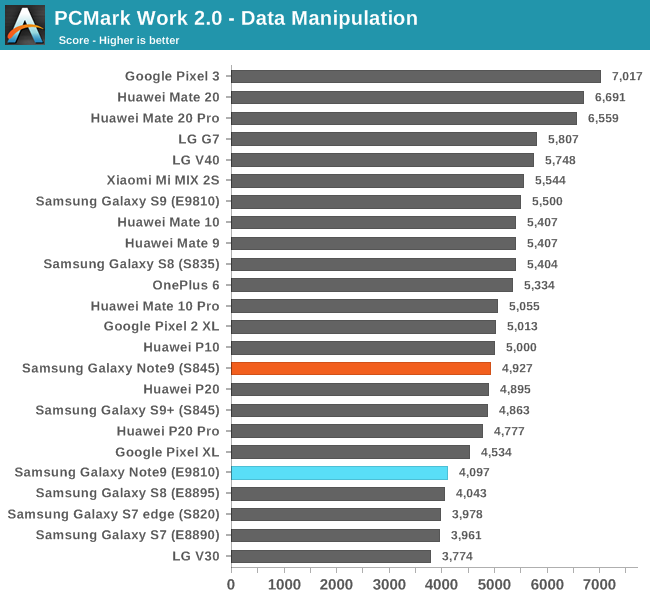
Finally, the data manipulation test is the most telling one in terms of the differences that Samsung has made on the Exynos model: Here the Note9 performs significantly worse than the Exynos Galaxy S9, coming in with a 34% lower score.
The data manipulation test is characteristic in the way it works in that it has a significant portion of heavy single-threaded processing. What’s actually happening on the Exynos Note9 here is that Samsung is disallowing the SoC to boost to its single-core 2.7GHz mode as often as the S9 originally did, a regression that I also encountered with my custom kernels on the S9.
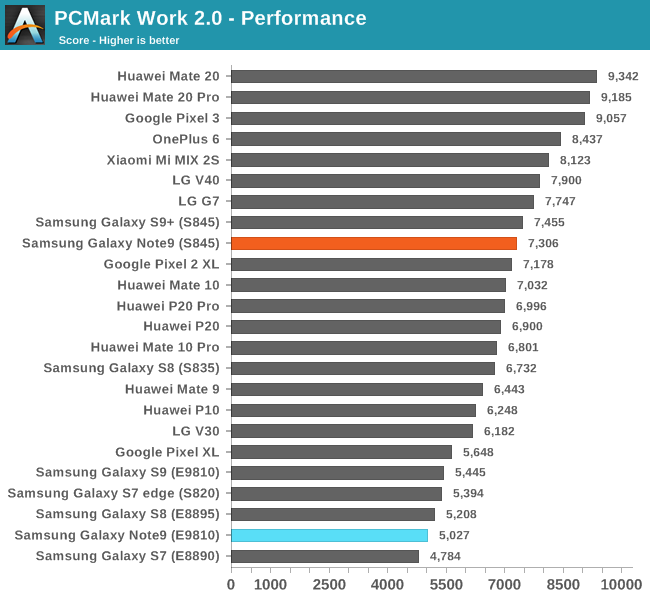
In terms of overall result, the Exynos Note9 falls in the ranks by several spots, now scoring even lower than last year’s Exynos 8895 S8, a not too fantastic showing.
Web browsing: less 2.7GHz – more actual performance?
The most evident result of the more prohibitive single-core booster is in the web browsing tests:
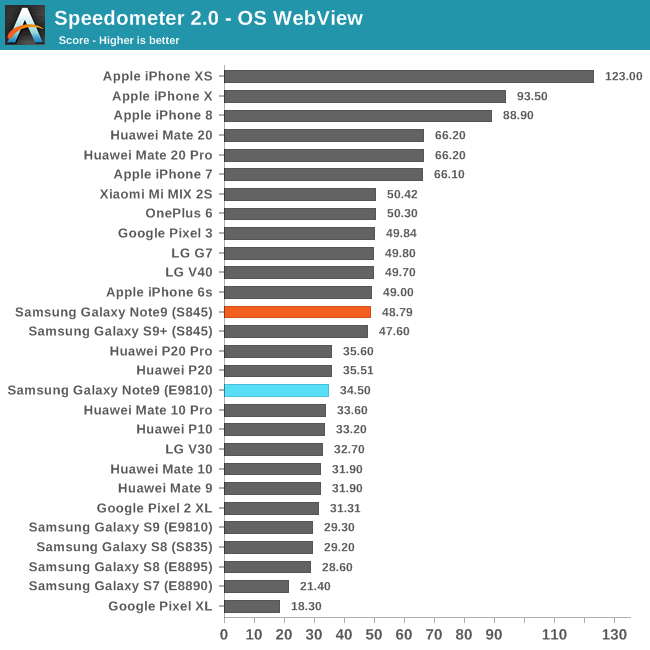
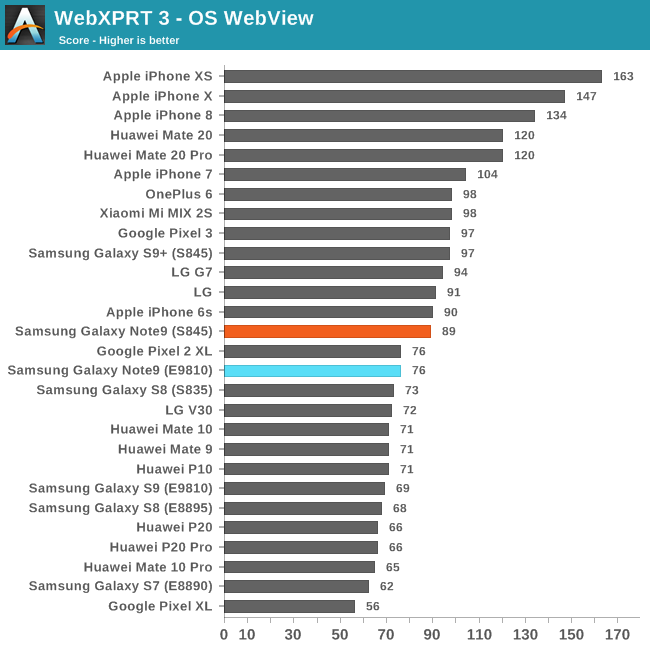
Both in Speedometer 2.0 and WebXPRT 3, the Exynos Note9 performs better than the S9 with its initial firmware. The result here is directly related to the decreased result of the data manipulation score in PCMark. As explained in our scheduler pieces, one of the reasons the Exynos S9 fared so badly in these tests is the core booster mechanism; boosting to 2.7GHz on a single big core while relegating all other threads to the small cores results in worse performance than simply if there were simply more big cores available, but at a lower clock speed. The latter scenario is what happens on the Note9 as why we see a 10% improvement over the S9.
The most low-effort band-aid
Overall, the actual changes in behaviour of the Exynos chipset in the Note9 represent nothing more than the most low effort changes possible. What Samsung has done here is just slightly change the booster mechanism in order make workloads more difficult to trigger the single-core 2.7GHz boost mode. For performance this is both beneficial as well as a regression, depending on workloads. What is more important is that the severe battery life impact of the 2.7GHz frequency is more significantly reduced through these changes, even though efficiency still doesn't match the Snapdragon 845 variant.
While performance has increased in the web benchmarks by around 10% - the overall result is still abysmal. Comparing the speed of the Snapdragon Note9 to the Exynos Note9 in just everyday usage, the Exynos still pretty much falls behind in every aspect. Samsung had a chance to improve things more drastically with the release of the new phone, but to me it just looks like another disappointment.
The Snapdragon Note9 is pretty much in line with other S845 devices: performance is a non-issue. While there are now more contrasting devices out there such as Huawei’s Mate 20’s – the Snapdragon Note9 is still a great device to use when it comes to its performance.










69 Comments
View All Comments
mfaisalkemal - Friday, November 23, 2018 - link
hi andrei, as always a great in depth analysis!i have two question,
1. would you tell me the avg. power consumption peak of A9 until A10 on t-rex and manhattan 3.1? because i curious about development of apple in term of gpu efficiency and how apple A9-A11 compare with other gpu like adreno and mali.
2. Any plan in review ipad pro 2018?
Andrei Frumusanu - Monday, November 26, 2018 - link
1. I don't have an accurate way to measure power on those devices and won't be investing time to get back to them.2. Brett is working on a review.
Barilla - Monday, November 26, 2018 - link
Why is Samsung even still trying to make Exynos work? Is it just because Apple has their own SoC and they want to belong to the club? Because purely on performance Qualcomm is clearly the superior choice for couple of generations now.A5 - Monday, November 26, 2018 - link
The R&D + manufacturing cost is probably less than what QC sells them a Snapdragon package for.They probably do the SD variant for the US because the CDMA patent royalties tip the equation the other way in that market.
goatfajitas - Monday, November 26, 2018 - link
"Why is Samsung even still trying to make Exynos work?"I would imagine it is because the last time that Qualcomm stumbled they had the fastest chip available. The SD810 was a disaster. If that happens again they need an alternative. But... yeah, this looks very poor today.
peterfares - Tuesday, November 27, 2018 - link
Yup, the 810 generation Samsung did what they hadn't done in a long time and used an Exynos CPU in all versions, worldwide. They had to buy an external modem from Qualcomm to use for the NAM variants too for CDMA support, which cost them much more money than just buying a SD810, but the SD810 was garbage and they had a good alternative. Every other phone that generation was horribly slow, especially my BlackBerry Priv.Targon - Monday, November 26, 2018 - link
Samsung uses Exynos for more than just some phones, they use it in their TVs and probably some other products as well. Continued work will help, but also, lower cost compared to buying from Qualcomm.ph00ny - Tuesday, November 27, 2018 - link
1. They need SoC for not only their mobile devices, they also have footprint in smart home devices, smart TVs, smart appliances, automotive, etc2. They've only been behind in two generations and they just started custom core soc. Give it some time.
nico_mach - Thursday, November 29, 2018 - link
Personally, I would love to see them support exynos models for more years than the Quallcomm chips, even if it means a performance hit. Phone performance is more than good enough imo so that would be a good tradeoff, and I presume that Samsung would make more money that way long term (keeping components in-house and creating loyal customers).Tams80 - Monday, December 3, 2018 - link
To decrease reliance on other companies if they need to, and also keep pressure on the companies they do work with.It's the same with Tizen. They don't need it, but it's a good backup and good leverage. As they are so huge, they can afford to keep developing their own solutions even if few of their products use them.